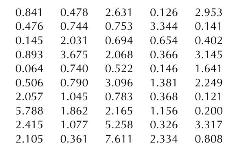Your company manufactures LCD screens that are used in the production of a popular smartphone sold by
Question:
Your company manufactures LCD screens that are used in the production of a popular smartphone sold by a major wireless cell phone service provider. The engineering department suggests that the operating life of the screen "likely" exhibits the memoryless property
\(P(x>s+t \mid x>s)=P(x>t) \forall s\) and \(t>0\)
where outcomes, \(x\), of the random variable \(X\) measure the operating life of the screen, measured in 100,000 hour increments, until failure of the screen. But they are not entirely sure of that as yet. A random sample of 50 of the LCD screens has been subjected to a test that accurately assesses their operating lives, and the following outcomes occurred:

(a) Define the EDF estimate of the underlying CDF for the screen lifetimes.
(b) Graph the EDF that you estimated in (a).
(c) What is the mean of screen lifetimes implied by the EDF?
(d) Treating the value you obtained in
(c) as if it were the true mean, plot the CDF implied by the memoryless property on top of the EDF plot in (b). Do they appear to be similar or not?
(e) What is the third moment about the mean implied by the EDF? Based on this value, would you conclude the PDF of screen lifetimes is symmetric probability distribution?
(f) Based on the EDF, estimate the probability that the screen will fail in 1 year if the screen were operating 24 hours/day.
(g) The anticipated useful life of the smartphone itself is five calendar years. If the screen is used for 4 hours per day, use the EDF to estimate the probability that the screen will not fail during the useful life of the smartphone.
Step by Step Answer:

Mathematical Statistics For Economics And Business
ISBN: 9781461450221
2nd Edition
Authors: Ron C.Mittelhammer




